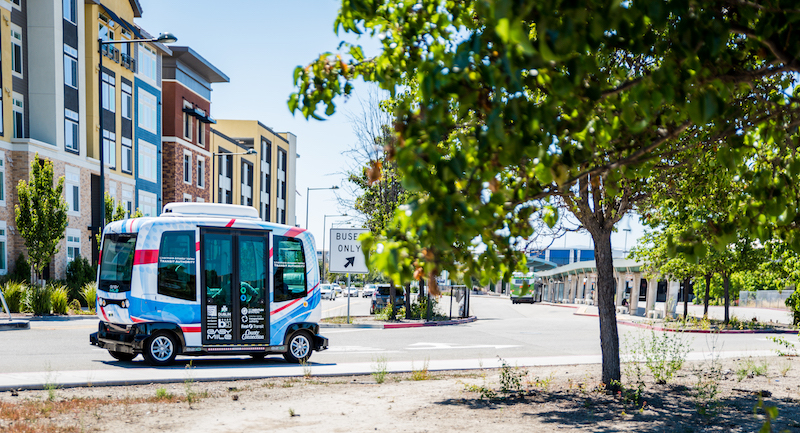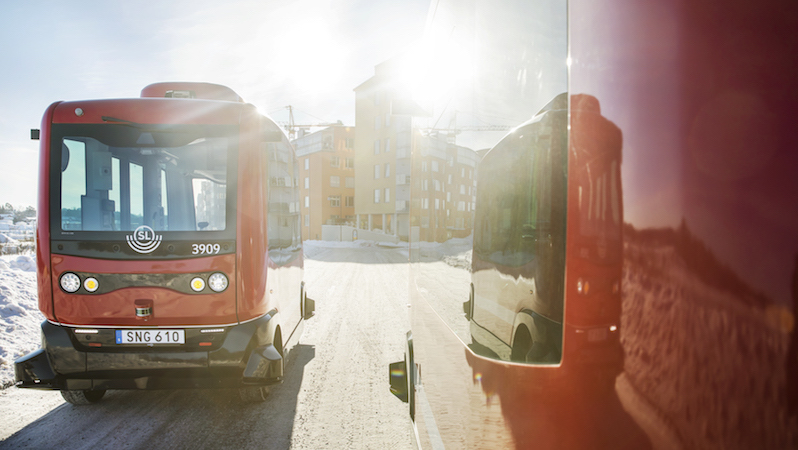Driverless Transport Will Speed Up Smart Cities
For many of us, the term “driverless technology” evokes a futuristic image of a car zipping down a freeway all on its own.
But right now, another type of autonomous vehicle—a small, box-shaped shuttle—is already shaping the way we move and plan, putting masterplanned communities on the fast track to becoming early beneficiaries of autonomous vehicle technology.
Of the many moving parts in the creation, design and development of a masterplanned community, architect Chris Maher of Hames Sharley explains that there are four key areas: planning and design; community; innovation and economics and, finally, governance.
“By considering all these aspects of a masterplanned community thoroughly and looking at integrating factors such as transport across each one, urban designers and planners develop a deeper understanding of the issues,” Maher said.
“Ultimately, this leads to a better-resolved master plan and more successful, sustainable place outcome, for all stakeholders.”
How autonomous vehicle technology can help with three immediate challenges
Sustainable masterplanned communities are often based upon a series of pillars—education, commercial, lifestyle and residential.
In turn, this often creates a large area hosting a collection of different precincts, leading to the following three challenges:
Heightened need for internal transport: Demand can be erratic and is often outside typical public transport operating hours
Linking with public transport: If residents need to walk more than 500 metres, they prefer to drive and park close by, creating the need for more car parking
Public car parking spaces will eventually run out: Urbanisation means there is less room to park at transport hubs, shopping centres, community spaces, hospitals and the like.
Simply put, residents of masterplanned communities have what is called a “first and last mile” transportation challenge, which leads to an over-dependency on private car ownership—and it's a problem that autonomous vehicle technology can resolve.
Autonomous vehicle technology can curb over-reliance on private car ownership

To understand the impact of overdependence on private car ownership, all you need to do is to take a look at the outer suburbs of Melbourne, where families with children of driving age are often forced into car ownership, owning at least two to three cars per household to cater for their mobility needs.
Not only does reliance on cars put financial pressure on families, it also presents challenges for the design of our living space, making driveways or garages bigger—which can mean having to choose between garden, or living space, and parking space.
And if indoor and outdoor private living space wasn’t already at a premium, Covid-19 has certainly helped tip the balance, changing perspectives on what private realm spaces are necessary and giving rise to the need for homes to provide not only relaxation and entertainment spaces but also comfortable remote working and learning areas.
Trends influencing masterplanned community design linking with autonomous vehicle opportunities
There are many factors architecture firm Hames Sharley considers across the four areas described earlier when developing a masterplanned community, with a priority being transport and the movement of people.
Enter EasyMile, with new technology in autonomous vehicles to improve access to public transport nodes that will enable many other benefits.
A recent Guardian report described a 70 per cent increase in bicycle ownership in the UK’s third-largest city, Manchester, together with a significant increase in local short trip movements to work and neighbourhood shopping centres during the pandemic.
This builds on an existing trend and focused strategy in many countries towards encouraging alternate modes of transport, rather than reliance on private car ownership.
Utilisation of autonomous vehicle technology can significantly reduce reliance on private car ownership and promote many other more sustainable benefits for cities and masterplanned communities.
Increased visitation and activity at local or neighbourhood centres has also been a recent focus of living with Covid-19, and this trend—together with the associated reduced requirement for car-parking space at these nodes—will assist many potential improvements to the design of future mixed-use centres.
These centres were traditionally defined by a “big box” surrounded by car parks that are empty for much of the time, a moat of inactivity and hot unshaded asphalt deterring walking and cycling.
By reducing private car ownership and therefore the need for so much land devoted to parking, there is a real opportunity to repurpose this space to create pedestrian-friendly streets, provide more net lettable or developable area, reduce construction costs, improve the integration of bicycle infrastructure together with more greenery, legibility and accessibility to our future neighbourhood centres.
According to CommSec data, since 2009, houses, townhouses, villas and apartments floorplans were generally becoming smaller in size in Australia, making available space more precious and valuable.
Space within apartments and houses—particularly in metropolitan areas—is becoming even more valuable as millennials enter the 34 to 44 year age bracket—a period when a large number will remain in apartment living.
Whether house or apartment, many of these dwellings will require in future greater space to accommodate a family with children—QBE data shows that 68 per cent of households in Sydney and Melbourne in this age group are made up of families with children.
Additionally, 2016 census data indicates that children are remaining at home longer, with some demographics and ethnic groups stillshowing a further preference for inter-generational housing.
These pre-Covid trends indicate the requirement for additional flexible space, which is further amplified by the need to accommodate working and learning at home—and family members isolating at home.
One solution is to convert space once used to accommodate cars to alternate uses that efficiently respond to households varied needs.
This is also important given the rise in land values in both inner metropolitan and suburban areas of our major cities.
Garages could in future become flexible spaces for working and learning remotely, with driveways, verges and carparks returned to green space for native plants or community gardens with all the benefits these changes may bring.
Where are autonomous vehicles being deployed to address private vehicle ownership levels?
Last year an Australian delegation visited the town of Barkarby in Sweden, one the largest urban development projects in the Stockholm region with a target of 40,000 citizens on completion.
In Barkaby, the local government area (Järfälla Municipality), transport authority (SL) and transport operator (Nobina) have worked together to integrate urban design, technology, and public transport to create what is arguably the world’s most modern public transport model.
Autonomous Vehicle shuttles have been deployed to eliminate first and last mile blackspots, and these shuttles are part of the greater commercial public transport network.
As a result, public transport satisfaction is up to 70 per cent and each household requires less space for car parking.
Could Australia have a similar appetite for autonomous vehicles as elsewhere?

The Barkarby example is part of a wider national innovation partnership program known as “Project KRABAT” that brings together government and private enterprises to explore the potential of automated vehicles.
While we may not have a similar setup in Australia yet, there have already been automated vehicle trials operating on public roads across the country.
According to a KPMG report, Australia ranks in the global top 10 regarding consumer acceptance of automated vehicles, ahead of countries such as France, South Korea, Japan, and China and even Germany, a nation traditionally been more advanced in automotive engineering and manufacturing.
In other words, Australia has the appetite for automated vehicle technology and there are regulatory frameworks to support these deployments nationally.
How will property values increase if autonomous vehicles can reduce private car ownership?
Research from the UK suggests that homes that have access to public transportation attract a premium.
For example, in London buyers will pay an average of 10.5 per cent more for a home that is within 500 metres of a tube station, but that premium subsequently drops the further away a home is from accessible public transport—with anything located more than 1,500 metres from a station losing any premium altogether.
The beauty of automated vehicle transportation is that it can operate on public roads without laborious infrastructure upgrades and can be deployed very quickly.
That and the fact that it has capability to cater for an on-demand service, while delivering a ride-sharing experience for 10-12 passengers at a time makes it a very compelling solution to consider.
Proximity to good public transport is historically a determinant in property value in Australia, and if the automated vehicle technology continues to develop and is planned to effectively integrate and connect with public transport nodes and routes it could help suppress the appetite for private vehicle ownership here too.
As the community becomes more aware of the many benefits and the technology advances, the conversation will develop and hopefully further acceptance and support for automated vehicles in Australia will follow.
This use of technology and innovation—together with behaviours and norms changing—is what will help transform our cities into smart cities.
The masterplanned community that dares, will win
Not all masterplanned communities are created equal, and the one that dares to integrate urban design and AV technology will have a winning market edge.
But it’s going to take a visionary with the foresight to acknowledge that reducing overdependence on vehicle ownership and creating “first and last mile” access to public transport through automated vehicle technology will result in more space to devote to other amenities.
Covid-19 has accelerated and confirmed that more flexible private living, working and learning space is paramount as we grasp the new realities of having to live and work from home.
To find out more about how to navigate and negotiate the journey to embracing automated vehicle technology, please drop us a line.
The Urban Developer is proud to partner with EasyMile & Hames Sharley to deliver this article to you. In doing so, we can continue to publish our free daily news, information, insights and opinion to you, our valued readers.














